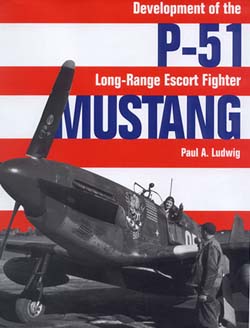 P-51 MUSTANG P-51 MUSTANG
Development of the Long-Range Fighter
By Paul A. Ludwig Classic Publications, UK,
2003, ISBN: 1-903223-14-8
MSRP: $56.95
Available from Specialty Press
Reviewed by Jim Schubert
First, a caveat; Paul and I have been close personal friends since 1972.
That bias notwithstanding, this is a fine book that definitely belongs
in the library of aviation enthusiasts who have a keen interest in the
technical, administrative, political, and command intricacies of WWII
in North America and Europe. Buy, and read, this book - you'll learn a
lot that will surprise you.
The German's aerial offensive early in the war was not nearly as effective as it could have been had they developed an adequate long-range escort fighter to accompany their bombers on missions to England. Failing to learn from this prime example, laid at their feet by the Germans, the Brits and the Yanks also failed to understand, and fill, the need for fighter escort for bombers all the way to the target and back and with sufficient fuel for a decent loiter time over the target. The powers that be remained convinced that high flying bombers could penetrate deeply into well defended enemy air space unescorted by fighters. It took a shamefully long time and the deaths of thusands of airmen for them to change their minds and accept the obvious and then do something about it. In this book Paul conducts us on a tour of the several overlapping and intertwined time lines of events that finally - almost amazingly - resulted in an Allied victory over Germany in the air. There were some terrible egos lusting for power and authority in the USAAF, who seemed more concerned with their personal status than with the lives of Allied airmen and the defeat of Germany. In my opinion, some of these miscreants ought to be posthumously court martialled! Reading of the high handed shenanigans of, for example, Colonel Oliver P. Echols of the USAAF is guaranteed to make you angry. Paul's massive and intensive research, over about 30 years, has equipped him to do a fine job of tracing the various overlapping and entwined time lines of events occurring in parallel to present his tale. This story tells of the development of the long-range escort fighter culminating in North American Aviation, Inc.'s P-51B, C, D and K Mustangs powered by Packard built Rolls Royce Merlin 60 (V-1650-3) vee-12 engines. Airplane type wise this story begins with the P-35, P-36, XP-37, etc. in the mid 1930's and goes through the XP-60 and all the "Request for Data 40C" or "R-40C" airplane projects and the families of, mostly, never built, exotic, liquid cooled, high output engines commissioned by the USAAF. (For a listing of these airframes and engines see the review of MPM's kit of the Northrop XP-56 "Black Bullet" in the September 2001 issue of this magazine.) Whilst all the talent, time, resources and money required to pursue these exotic airplanes and engines was being squandered, North American designed, built and delivered their Allison V-1710 engined NA-79 Mustang I, (later P-51A in the USAAF) for, and to, the RAF. The USAAF's Materiel Command studiously ignored, and damned, this airplane until it was almost too late to develop and produce it. It is especially painful to read, even at this remove in time, of the problems experienced with the P-47 and the P-38 as escort fighters whilst the Mustang was being ignored as "Not Invented Here". Our British allies were, however, quick to realize the potential of their Allison Mustang and installed the Merlin 28 in several airframes for study. And, of course, we all know how this tale played out. Nonetheless, this is a good read - rather like a who dunnit and even though you know the end result, you'll keep turning the pages to make sure it turns out the way you think you remember it did. It did - we won. An interesting technical revelation is in Paul's telling of the reasons for the re-engined Mustang being faster in level flight than the Spitfire Mk.V equipped with the same Merlin 28 engine. We've heard a lot over the years about the Laminar Flow Airfoil. More recently we've been hearing quite a bit about the Meredith Effect producing "jet-thrust" from the radiator exit. Now Paul shows us that the major reason for the Mustang's lower drag lies in the fact that from their placement of the wing, cockpit canopy and radiator housing relative to one another, North American unwittingly applied the Whitcomb Area Rule to their airplane years before Richard Whitcomb of the NACA defined the effect. They struck it lucky! For those concerned about specifics this book has: Hardcovers,
224 numbered pages,
357 black & white photos,
14 color photos,
18 color profiles,
6 drawings,
5 copies of document pages,
Sources list,
References list,
Glossary of abbreviations and an
Index. My personal taste in this kind of history would be for it to have a large - perhaps a foldout - time line chart so that we could more easily follow the several labyrinthine parallel plots, some maps for geographic orientation of the various commands, a bit more on the Douglas DS-312A that so impressed Hap Arnold, pictures of all of the R-40C projects, pictures and specs of all the exotic engines being developed for the USAAF and several military/government/industry organization charts. Of course, adding all this good stuff would probably make the book much too big and much too costly.
My nit-picking druthers aside, this is a good book; buy one and learn
a lot from it as I did.
This title, along with others from Classic Publications, is available
from Specialty
Press. Check their website for other great books. | 








|
 P-51 MUSTANG
P-51 MUSTANG







